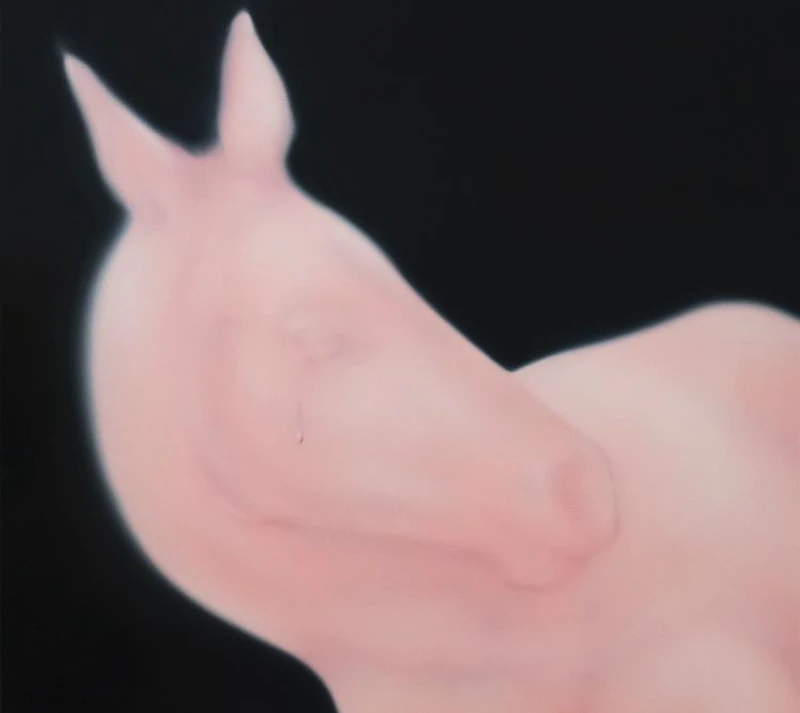Julia Kowalska: Milky Blind Eye
21 Apr-20 May 2023
PV 20 Apr 2023, 6-9pm


Kravitz Contemporary in collaboration with Death of Man Gallery presents a solo exhibition of new works by Warsaw based painter Julia Kowalska (b. 1998). Milky Blind Eye is Kowalska’s first international solo exhibition, and follows the artist’s participation in Kravitz’s group show Under the Jaguar Sun (Oct/Nov 22) and Death of Man’s presentation at Hotel Warszawa Art Fair (Nov 22). This show continues Kravitz’s programme of collaborative shows with international based galleries, curators and artists hosted at the gallery’s Soho Square space, and has been curated by FIELDNOTES editor and White Cube Exhibitions Coordinator Elaine Tam.
Exhibition text by Hector Campbell:
During the span of her undergraduate study at Warsaw’s Academy of Fine Arts, Julia Kowalska intensely interrogated the importance of figuration, that corporeal consideration currently so prevalent in the field of contemporary painting. Beginning by physically looking inward, she produced a series of sinuous almost biological abstractions that flayed the figure and exposed every gastroenteric, pulmonary or cardiovascular component that underpins our ongoing existence, all amalgamated into a mass of rich sanguine reds and putrid prurient pinks. Now, however, in her latest paintings produced for Milky Blind Eye and those displayed at her recent degree presentation, Kowalska applies a more transcendental approach to introspection. A spiritual soul-searching that, rather than using the body as an agent for abstraction, attempts to instead abstract the body from the figure itself.
The corporeal palette remains, although softened into signature pastel, powdered pinks that appear radiant against the dark, distempered void of the canvas expanse. A hazy halo engulfs each figure as if their spectral skin is translucent and protects an internal light source, an intramural luminescence. The tenebrous, barren backgrounds root each shadowy scene in Kowalska's delicately devised dreamscape, a simulated subconscious from which ephemeral performances present themselves in the foreground, before fading once again into the recesses of a restful or restless psyche. The artist’s interest in, and examination of, certain psychoanalytical arguments, or critical creative treatise, conceptually sustains such hallucinatory histrionics. Be it Julia Kristeva’s uncanny-adjacent theory of abjection, Freud’s own famed unheimlich fascination with fleeting familiarity or the dramatic defamiliarization favoured by 20th-century Russian formalists.
Throughout, the body serves as barrier, battleground and boundary line, skin the superficial site of indiscernible care or conflict. Physical touch is present in much of Kowalska's output, yet its motives are often not didactically defined or easily digestible. Touch here represents both the ways in which we experience the world around us, and the ways in which the world often impresses or impedes itself upon us. The body keeps the score of past and present interpersonal or romantic relationships, and Kowalska is well aware of the ambiguities that being physically involved with another brings. Those contradictions introduced by tactility, the potential to bring pleasure, pain and perhaps both at once. It is these unknowing nuances, these undefined dichotomies that play out across each painting, the pendulum balanced perfectly between affection and fear, desire and dismissal, embrace and attack.
Abandon any hope of elucidation by turning to the artist’s titles, themselves poetic and lyrical as if excerpts from some larger as yet unknown sources, as whilst they each contain snippets of plausible potential again a didactic description is withheld. For as generous as the artist is with style and subject matter, ultimately the viewer must bring themselves to the paintings and arrive at their own emotional impression and apprehension. Here, Kowalska has achieved that rarified abstraction not from semblance but from sense, the body indeed abstracted not only from the figure but also from narrative, location, time and even intention.
Julia Kowalska is a visual artist based in Warsaw. Born in 1998, graduate of the Painting Faculty at Academy of Fine Arts in Warsaw in 2022.
Her work reffers to human relationships, in which the artist seeks moments lined with ambiguity and explores the ambivalent nature of communing with the body. The enigmatic and ephemeral character of dream perception embeds the artist’s work in a sense of repetitive disorientation, while the ambivalent gestures and expression of the depicted figures sensually narrate thecomplexity of mutual relationships based on emotional dependencies and divergent affections.